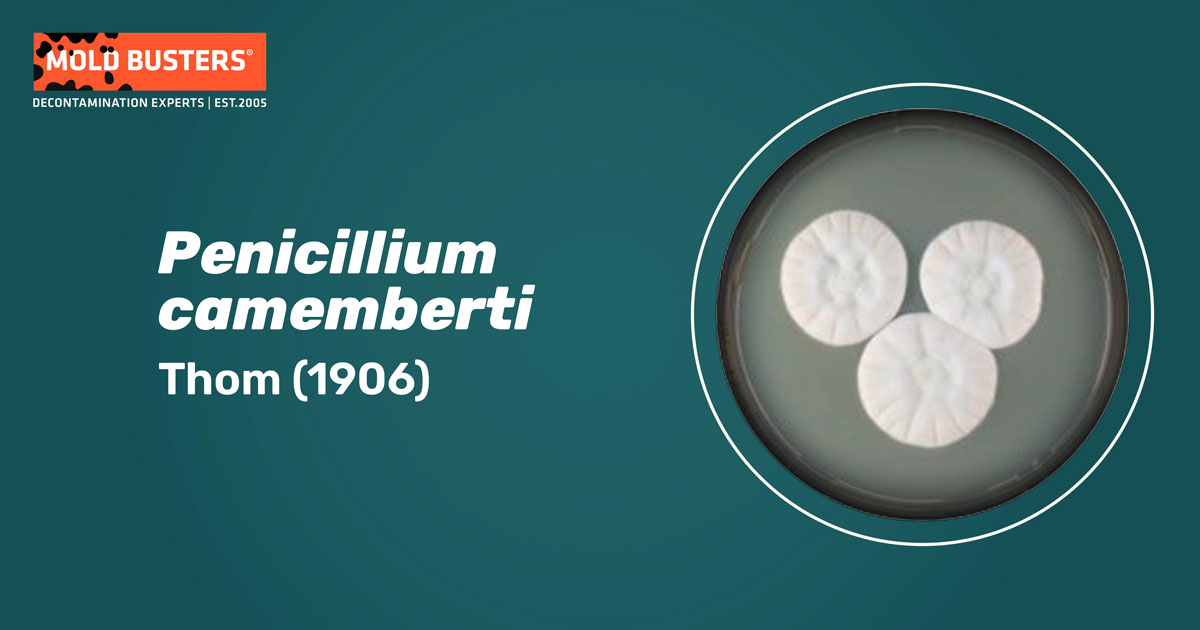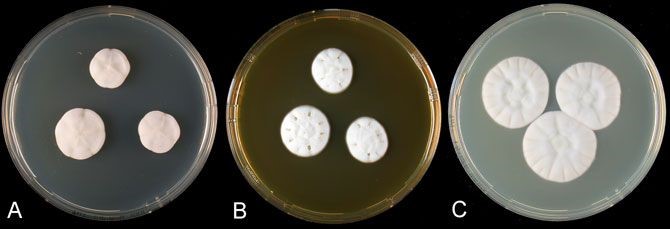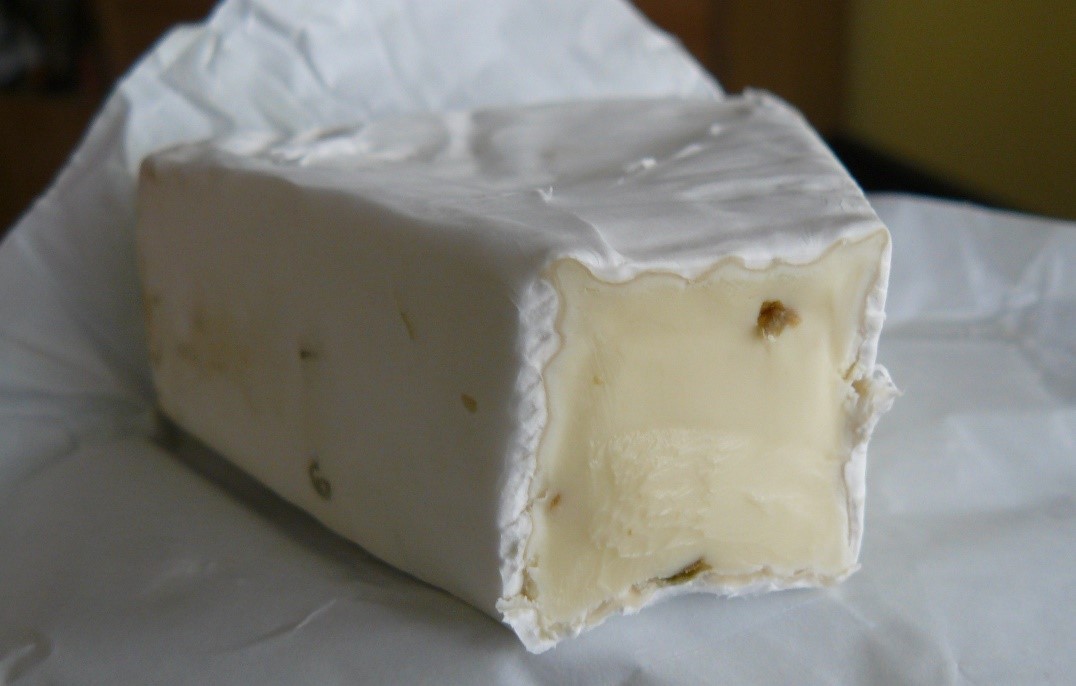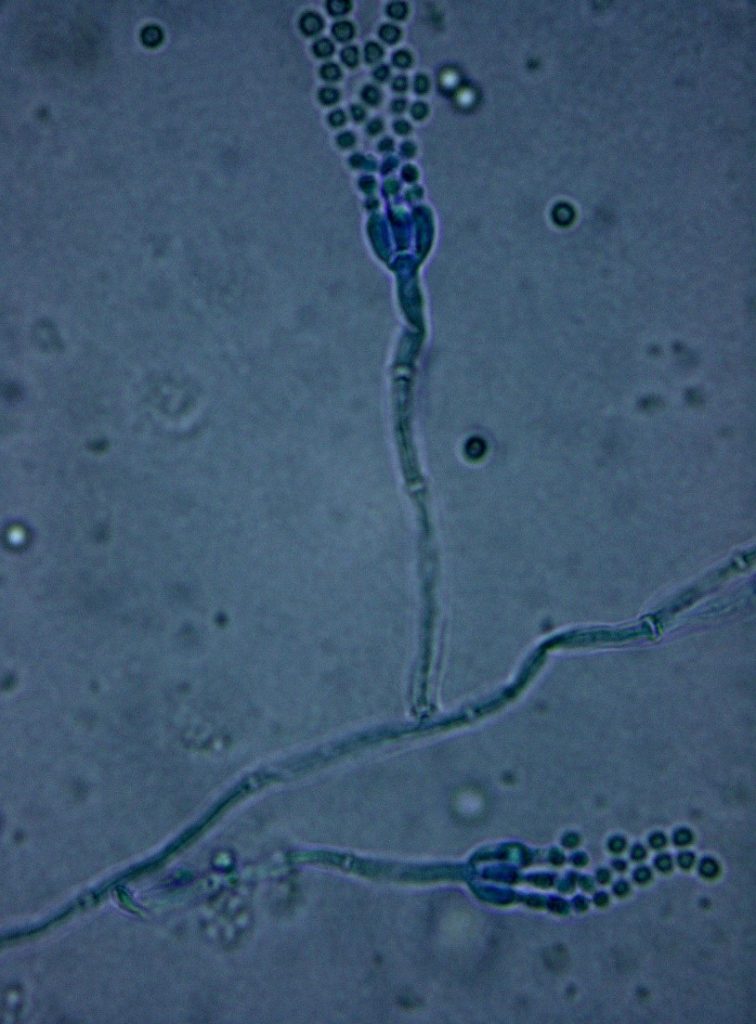Thom (1906)
What is Penicillium camemberti?
Penicillium camemberti is a filamentous fungus from the genus Penicillium, also known under the synonyms P. rogeri, P. candidum, and P. caseicolum. Since P. camemberti is used in the production of Camembert and Brie cheese, this mold species is mainly found on cheese, forming a white, fluffy crust. It can also be found in a cheese factory environment, meats, and pecans [1].

What does Penicillium camemberti look like?
Penicillium camemberti produces colonies ranging from 19–27 mm (0.7-1 inch) in diameter, on Czapek yeast extract agar (CYA) after 10 days [1]. Some strains produce colonies that remain persistently white (Fig. 1) [2], sometimes colored pale grey due to produced conidia when the colony matures [1]. On malt extract agar (MEA) colonies are somewhat smaller, typically 12–27 mm (0.57–1 inch) in diameter [1]. Certain strains may seldomly range from yellow-orange to green.

The optimum growth temperature ranges from 20–25 °C (68–77 °F). There are reports suggesting that P. camemberti can grow at 5°C (41 °F) but is not capable of growing at 37 °C (98.6 °F) [1].
Being a strictly anaerobic fungus, P. camemberti grows exclusively on the surface of the cheese (Fig. 2). Its mycelium is called a “bloom” and is roughly 3 mm (o.1 inch) thick, white, or light gray [2].
Underneath this surface crust is a thin, dark, orange-to-brown layer formed by other microorganisms (yeasts and surface bacteria) [2]. The mycelium of P. camemberti from cheese exists in two states: the raw mycelium is thick and fluffy, but during the conditioning of cheese it becomes thin and compact, which is the result of compression between the cheese crust and the packaging film [5].

What is the structure and morphology of Penicillium camemberti?
Penicillium camemberti forms irregular conidial heads with several levels of branching [3]. Conidiophores are usually two-staged or three-staged branched, arising mostly from submerged hyphae and occasionally from aerial hyphae [4]. Conidiophores are often rough-walled, bearing elongated conidiogenous cells (Fig. 3). Conidia are elliptical, smooth, produced in chains, 5 x 4.5 µm [3]. They can be glass-like or greenish [4].

Penicillium camemberti advantages
Penicillium camemberti is most famous for cheese production. It is mostly used to ripen Camembert and Brie cheeses, giving them a distinct appearance and flavor [1, 5]. Ripening is the result of enzymatic processes taking place in cheese due to the microbiological flora provided in the starter. Besides P. camemberti, the starter includes lactobacilli, yeasts, and surface bacteria. A part of this mixture is added to milk before coagulation, while P. camemberti is sprayed onto the cheese surface after salting [1].
Penicillium camemberti is also used as a secondary starter culture in cheese production as a biocontrol agent that inhibits the undesirable growth of common fungal contaminants such as Cladosporium herbarum, P. roqueforti, P. caseifulvum, and P. commune [1].
Penicillium camemberti is also used as a starter culture for fermented meat products such as sausages. It is often found as a spontaneous colonizer originating from the production environment. The mycelium of P. camemberti developed on the surface of the sausages prevents chemical degradation of the fatty compounds, improving the odor and flavor of the final product. It also helps eliminate the growth of undesirable mold contaminants [1].
There are reports on the application of P. camemberti in the decontamination of ecologically undesirable chemicals used in the softwood bleaching process, which contain high levels of phenolic and chlorinated phenolic compounds [1].
What are the harmful effects of Penicillium camemberti?
Certain strains of P. camemberti have been reported to produce compounds with adverse health effects [1]. These compounds are known as secondary metabolites, since they are not essential for fungal growth and reproduction, but can play an important role in its survival. Some of these secondary metabolites produced by P. camemberti are cyclopaldic acid (CPA), rugulovasine A, rugulovasine B, and palitantin [1].
CPA is the most significant of them due to its neurotoxic and immunosuppressive properties. CPA is found in the rind of the cheese but not in its core, since P. cammeberti grows only on the cheese surface. Its neurotoxicity causes increased muscle contraction [1].
However, CPA is not considered a major threat to consumers of Camembert and Brie cheeses since the highest possible level has been estimated to be less than 4 µg CPA in a portion of the most highly contaminated cheeses. According to the reports, harmful long-term effects from the consumption of P. camemberti ripened cheese is unlikely [1].
However, improving starter strains of P. camemberti by removing toxic metabolite gene clusters from their genome could be of great importance in the food industry [6].

Did you know?
Stachybotrys is the 2nd common toxic mold type found in homes we tested?! Find out more exciting mold stats and facts on our mold statistics page.
References
- Abbas, A. and Dobson, A. D. W. (2011). Encyclopedia of Dairy Sciences. Second edition. Academic Press. Chapter: Yeasts and Molds. pp: 776-779.
- Leclercq-Perlat, M. N. (2011). Encyclopedia of Dairy Sciences. Second edition. Academic Press. Chapter: Yeasts and Molds. pp: 773-782.
- Onions, A. H. S. and Brady, B. L. (1987). Penicillium and Acremonium. Springer Science+ Business Media, LLC, New York. Chapter 1, pp: 22-23.
- Samson, R. A. et al. (1977). The taxonomy of Penicillium species from fermented cheeses. Antonie van Leeuwenhoek, 43: 341-350.
- Bizet, C. et al. (1997). Composition and physical properties of the Penicillium camemberti mycelium. Dairy Science & Technology 77(4): 461-466
- Martin, J. F. and Liras, P. (2017). Fungal Metabolites. Springer, Cham. Chapter: Secondary Metabolites in Cheese Fungi. pp: 293-315.

Get Special Gift: Industry-Standard Mold Removal Guidelines
Download the industry-standard guidelines that Mold Busters use in their own mold removal services, including news, tips and special offers:

Written by:
Jelena Somborski
Mycologist
Mold Busters
Edited by:
Dusan Sadikovic
Mycologist – MSc, PhD
Mold Busters
